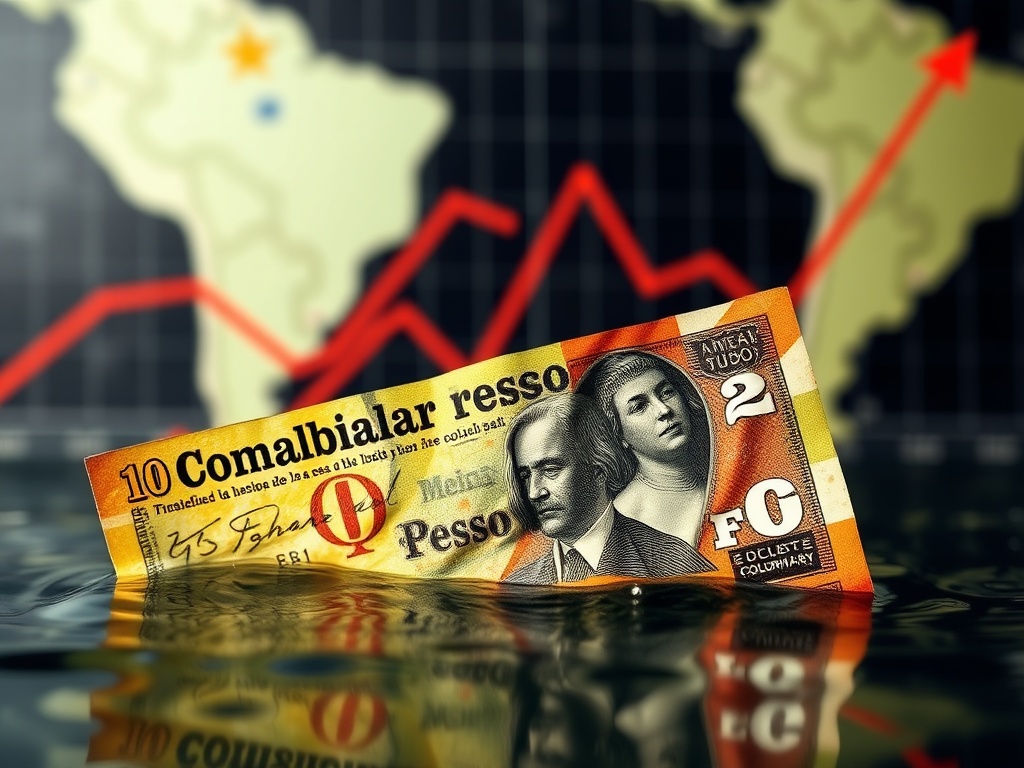BitcoinWorld

Shocking Colombian Peso Forecast: Dire Decline Predicted by 2026
In the dynamic world of finance, where digital assets often grab headlines, it’s crucial to remember the foundational role of traditional currencies. For investors closely watching the ebb and flow of global markets, particularly those with stakes in emerging economies, a recent warning about the Colombian Peso forecast sends ripples across Latin America. Capital Economics, a prominent London-based independent economic research consultancy, has issued a stark prediction: the Colombian Peso is set to become the worst-performing currency in Latin America by 2026. This isn’t just a number; it’s a signal that could impact everything from trade balances to investment strategies, raising questions about the stability of the region’s financial landscape.
What’s Behind the Dire Colombian Peso Forecast?
The pronouncement from Capital Economics isn’t made lightly. Their analysis suggests a confluence of factors will drive the Colombian Peso forecast down significantly over the next few years. The report specifically highlights concerns around Colombia’s economic policies, its reliance on commodity exports, and broader global economic shifts. This prediction positions Colombia in a precarious spot, potentially undermining investor confidence and impacting the cost of living for its citizens. For many, understanding currency movements can seem complex, but at its core, it reflects a country’s economic health and future prospects. A weakening currency can make imports more expensive, fuel inflation, and deter foreign investment. Conversely, it can make exports cheaper, which might offer some relief, but often the negative impacts outweigh the positives, especially for economies heavily reliant on external trade.
Capital Economics’ methodology often involves rigorous econometric modeling combined with deep qualitative analysis of political and social factors. Their track record in predicting market trends lends significant weight to this particular warning. Historically, the Colombian Peso has experienced periods of volatility, often influenced by global oil prices and domestic political shifts. However, the current forecast suggests a more sustained and structural decline, moving beyond typical cyclical fluctuations. This implies that the underlying economic fundamentals and policy directions are seen as diverging negatively from regional peers, setting the stage for a prolonged period of weakness. The firm’s reputation for independent and often contrarian views means their assessments are taken seriously by institutional investors and policymakers alike, making this Colombian Peso forecast a critical point of discussion.
How Will Colombia’s Peso Stack Up Against Other Latin America Currency Rivals?
Capital Economics’ warning isn’t just about Colombia in isolation; it’s about its relative performance within the region. While other Latin America currency units like the Mexican Peso and the Brazilian Real have shown resilience or faced their own challenges, the Colombian Peso is singled out for a particularly steep decline. The report suggests that by 2026, the Colombian Peso could depreciate by an additional 15% against the US Dollar from its current levels, making it a stark outlier. This projection contrasts sharply with the expected performance of its neighbors, many of whom are either benefiting from global trends or managing their internal economic pressures more effectively.
Consider the diverse economic landscapes within Latin America:
- Mexico: Benefiting from nearshoring trends, strong trade ties with the US, and a relatively stable macroeconomic framework. Its currency, the Mexican Peso, has often been a bellwether for emerging markets, demonstrating resilience even amidst global headwinds due to its robust manufacturing sector and significant remittances from the United States. This strong external position provides a buffer against volatility.
- Brazil: Grappling with persistent fiscal challenges but also a large, diversified economy with significant agricultural and industrial output. The Brazilian Real’s performance is often tied to commodity prices and domestic political stability, showing periods of strength when global risk appetite is high and its agricultural exports are booming. Its large internal market also offers some insulation.
- Chile: Heavily reliant on copper exports, but with relatively strong institutions, a history of prudent fiscal management, and a deep capital market. The Chilean Peso’s movements are closely linked to global copper prices and China’s economic health, but its strong institutional framework often provides stability.
- Peru: Another significant commodity exporter (copper, gold, silver), often subject to political instability but with strong foreign reserves and a history of sound macroeconomic policies. The Peruvian Sol has historically been one of the more stable currencies in the region, despite political turbulence, largely due to its fiscal discipline.
The comparison underscores that Colombia’s specific vulnerabilities, rather than a generalized regional downturn, are driving this bleak outlook. While other Latin America currency units may face their own pressures, Colombia’s unique policy trajectory and structural issues appear to set it apart. Investors looking at diversified portfolios across Latin America currency options will need to pay close attention to these distinctions, as a ‘one-size-fits-all’ approach to regional investments may prove costly. The Peso’s predicted underperformance serves as a critical indicator of Colombia’s unique challenges within the broader regional context.
What Factors Are Fueling This Predicted Peso Depreciation?
The anticipated Peso depreciation isn’t a single-cause phenomenon. Capital Economics points to several key drivers, each contributing to a challenging economic environment and eroding investor confidence:
- Fiscal Concerns: Doubts persist about the government’s ability to manage its budget deficit effectively. Increased public spending, particularly on ambitious social programs proposed by the current administration, without corresponding revenue generation or a clear, credible plan for fiscal consolidation, can lead to a widening fiscal gap. This often pressures the national currency as markets perceive a higher risk of sovereign debt accumulation and potential future monetization of debt, which fuels inflation. Colombia’s public debt-to-GDP ratio, while not the highest in the region, is a concern given its reliance on volatile commodity revenues and the political challenges of implementing austerity measures. Ratings agencies are closely watching these developments, and any downgrade to Colombia’s sovereign credit rating could exacerbate currency weakness by increasing borrowing costs and deterring foreign capital.
- Policy Uncertainty: The current administration’s proposed reforms, particularly in the energy, pension, and health sectors, have created an environment of unpredictability that significantly impacts investor sentiment. President Gustavo Petro’s proposals to halt new oil and gas exploration contracts, for instance, are deeply controversial. Colombia is a significant oil exporter, and these policies could severely impact future export revenues, a critical source of foreign exchange for the country. Such radical shifts in policy, especially concerning a nation’s primary export, send strong negative signals to international investors, contributing significantly to Peso depreciation. The lack of clear implementation plans, coupled with political gridlock and legislative challenges surrounding these reforms, further amplify uncertainty, making long-term investment decisions difficult.
- Commodity Dependence: Colombia remains highly dependent on oil and coal exports, which historically account for a substantial portion of its foreign exchange earnings and government revenues. While global commodity prices have seen fluctuations, a sustained downturn or a structural shift away from fossil fuels globally (e.g., due to the accelerating energy transition and climate change policies) could severely impact Colombia’s export earnings. This dependence makes the economy inherently vulnerable to external shocks in commodity markets, directly contributing to Peso depreciation when these markets are unfavorable. The long-term global push towards renewable energy poses a significant existential threat to Colombia’s traditional export model, requiring urgent diversification that has yet to fully materialize.
- High Interest Rates & Inflation: While the central bank (Banco de la República) has aggressively raised interest rates to combat persistently high inflation, this tight monetary policy also has its downsides. Persistently high inflation erodes purchasing power, reduces real wages, and can make a currency less attractive to foreign investors who seek stable returns. The delicate balance between taming inflation and avoiding a severe economic slowdown (stagflation) is a significant challenge for policymakers. High interest rates, while designed to attract capital by offering better returns, can also stifle domestic investment, increase the cost of borrowing for businesses, and dampen consumer spending, potentially leading to a deceleration in economic growth.
These interconnected factors create a challenging economic environment that is likely to weigh heavily on the Colombian Peso’s value, signaling a difficult period ahead for the nation’s currency and its economic stability.
What Does This Mean for the Broader Colombia Economic Outlook?
The predicted Colombia economic outlook is intricately linked to the currency’s performance. A significant depreciation of the Peso could lead to a cascade of economic consequences, impacting various facets of the economy and society:
- Increased Inflation: The most immediate and tangible impact. Imported goods, from consumer electronics to essential food staples and industrial machinery, become significantly more expensive. This directly impacts consumer prices and household budgets, severely eroding the purchasing power of ordinary citizens. Businesses reliant on imported inputs will face higher costs, which they may pass on to consumers, fueling a vicious cycle where the central bank might need to maintain even higher interest rates, potentially stifling economic growth and leading to a recession or even stagflation (high inflation with stagnant growth).
- Reduced Foreign Investment: A volatile or depreciating currency makes a country less attractive for foreign direct investment (FDI). Investors seek stability, predictability, and a reasonable return on investment, and a weakening Peso signals heightened risk and uncertainty regarding future profitability when converting earnings back to their home currencies. This could lead to a slowdown in job creation, limit technological transfer, and hinder critical infrastructure development, all vital for long-term economic growth. Furthermore, the risk of capital flight, where both domestic and foreign investors move their money out of the country in search of safer or more profitable havens, becomes a significant concern.
- Higher Debt Burden: A substantial portion of Colombia’s public and private debt is denominated in foreign currencies, primarily the US Dollar. As the Peso weakens, the cost of servicing this debt in local currency terms increases significantly. This puts further strain on the government’s finances, potentially diverting funds from essential public services like education, healthcare, and infrastructure. For private companies with foreign currency debt, the increased burden can lead to financial distress, bankruptcies, and a rise in non-performing loans within the banking sector. The government might be forced to cut spending or raise taxes to manage this escalating debt, further dampening economic activity.
- Social Impact: Beyond purely economic indicators, currency depreciation and inflation have profound social consequences. Rising costs of living can exacerbate poverty and inequality, disproportionately affecting vulnerable populations. This economic distress can potentially lead to social unrest, protests, and increased political instability, creating a feedback loop that further damages investor confidence. Access to imported medicines, technology, and even certain foods can become limited or prohibitively expensive for the average Colombian, directly impacting their quality of life and human development indicators.
The government’s response to these multifaceted challenges will be crucial. Implementing sound fiscal policies, fostering investor confidence through clear and consistent communication, and diversifying the economy away from heavy commodity reliance are essential steps to improve the long-term Colombia economic outlook and mitigate the predicted currency weakness. The coming years will be a significant test for Colombia’s economic resilience and its political leadership.
How Does This Impact the Broader Landscape of Emerging Market Currencies?
The situation with the Colombian Peso serves as a cautionary tale for investors in emerging market currencies globally. While each emerging market has its unique set of challenges and opportunities, common themes often dictate currency performance and investor sentiment across the board:
- Global Interest Rates and Capital Flows: Higher interest rates in developed economies, particularly the US (driven by the Federal Reserve’s monetary policy), can draw capital away from emerging markets. This phenomenon, often referred to as ‘carry trade unwinding,’ occurs when investors shift funds from higher-yielding but riskier emerging market assets to safer, now more attractive, developed market bonds. This outflow of capital puts significant downward pressure on emerging market currencies, as demand for them diminishes.
- Commodity Prices: Many emerging markets are net commodity exporters (like Colombia) or importers. Fluctuations in global commodity prices directly impact their trade balances, current account deficits, and ultimately, currency strength. A sustained decline in prices for a key export, or a surge in prices for a key import (like oil for non-oil producers), can rapidly deplete foreign reserves and weaken the local currency.
- Political Stability & Policy Predictability: Investors prioritize stability and clear, consistent policy frameworks. Uncertainty stemming from frequent changes in government, social unrest, or unpredictable policy shifts (especially concerning foreign investment, property rights, or key industries) can quickly erode confidence in emerging market currencies. Colombia’s current political climate and proposed reforms exemplify this risk, demonstrating how domestic policy can have international financial repercussions.
- Fiscal Health: Countries with sound fiscal management, manageable debt levels, and transparent governance tend to have more resilient currencies. Conversely, persistent budget deficits, rising public debt, and perceived fiscal irresponsibility are major red flags for investors, often leading to currency depreciation and higher borrowing costs as risk premiums increase. The ability of a government to collect taxes efficiently and manage its expenditures prudently is a cornerstone of currency stability.
- Geopolitical Risks: Broader geopolitical tensions, trade wars, or regional conflicts can also disproportionately impact emerging markets, leading to heightened risk aversion and capital flight. These external shocks can quickly unravel years of economic progress and undermine investor confidence, making emerging market currencies particularly susceptible to global events.
For investors, the key takeaway is the importance of detailed, country-specific analysis rather than broad generalizations about emerging markets. The Colombian Peso’s struggles highlight the need for vigilance and a nuanced understanding of local economic and political dynamics when navigating the complex world of emerging market currencies. While the allure of higher yields in emerging markets can be strong, the risks, as demonstrated by Colombia, are equally significant and demand careful consideration.
Navigating the Challenges: What’s Next for Colombia?
The path forward for Colombia involves navigating significant challenges and making difficult policy choices. The government faces the delicate task of implementing reforms that foster long-term growth without destabilizing the economy in the short term. This includes finding a delicate balance between ambitious social spending commitments and stringent fiscal responsibility, and ensuring that energy policies support both environmental goals and economic stability without jeopardizing the nation’s primary revenue streams. For businesses and individuals, preparing for potential inflationary pressures and currency volatility will be paramount, requiring careful financial planning, diversified asset allocation, and robust risk management strategies.
Actionable Insights for Investors:
- Diversification: Consider diversifying your portfolio beyond single-country exposure in Latin America. Spreading investments across different economies and asset classes can mitigate risks associated with specific country downturns or currency weaknesses.
- Hedging Strategies: For those with existing exposure to the Colombian Peso or Colombian assets, exploring currency hedging strategies (e.g., through forward contracts, options, or other derivatives) might be prudent to protect against further depreciation and mitigate potential losses.
- Long-Term View: While the short-to-medium term outlook appears challenging, assess long-term fundamentals and potential for recovery. Economic cycles turn, and a country’s resilience can sometimes surprise, especially if structural reforms are eventually implemented effectively and consistently.
- Monitor Policy: Keep a close watch on government policy announcements and their implementation, especially regarding fiscal, energy, and social reforms. Policy clarity, consistency, and market-friendly adjustments will be key determinants of investor confidence and the Peso’s future trajectory.
- Fundamental Analysis: Prioritize deep fundamental analysis over speculative trading. Understand the underlying economic health, debt levels, export base, political stability, and institutional strength before making investment decisions. This approach helps in identifying true value and avoiding short-term pitfalls.
A Compelling Summary: The Road Ahead for the Colombian Peso
The warning from Capital Economics about the Colombian Peso forecast is a significant development that demands attention from global investors and policymakers alike. Predicting the Peso to be Latin America’s worst-performing currency by 2026 underscores deep-seated economic and policy concerns within Colombia. From persistent fiscal pressures and heavy commodity dependence to profound policy uncertainty stemming from ambitious government reforms, the factors contributing to this anticipated Peso depreciation are multifaceted and complex. While the immediate Colombia economic outlook presents considerable challenges, understanding these dynamics is crucial for anyone with a vested interest in the region or in emerging market currencies. The coming years will undoubtedly test Colombia’s resilience and its ability to adapt to both internal pressures and external economic headwinds, making it a critical case study in the ever-evolving global financial landscape and a stark reminder of the intricate link between policy, economics, and currency strength. Navigating this period will require strategic foresight from the government and careful consideration from investors seeking opportunities in Latin America.
To learn more about the latest Forex market trends, explore our article on key developments shaping Latin America’s economic landscape and emerging market currencies.
This post Shocking Colombian Peso Forecast: Dire Decline Predicted by 2026 first appeared on BitcoinWorld and is written by Editorial Team





